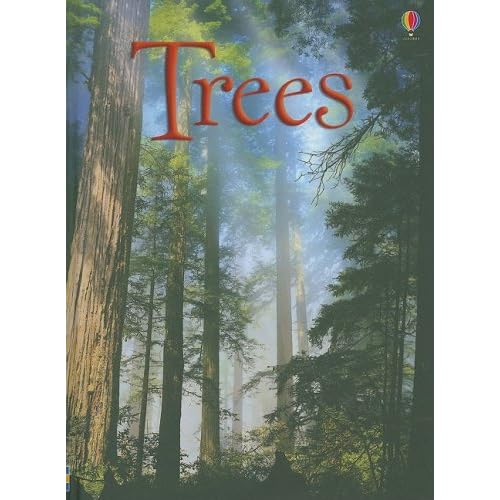It has been a LONG while since I've posted on here - Adventure-Man was 3 when I started and now he's four and a half! My absence from blogging is fully explained here, so I won't go over old ground again. I'll just get back to the business of recording our days spent learning and playing.
Being back in England has been great for our nature studies and I decided to ease us back into our homeschooling routine by creating a short little fun unit study on trees.
 We started off with making a cover for our tree book using stencils from Dover Press' Fun with Trees Stencils.
We started off with making a cover for our tree book using stencils from Dover Press' Fun with Trees Stencils.We then read from a selection of books. Usborne's Trees (Beginners) is a great little introductory book from which we learnt the different parts of a tree, that they have different shapes and heights, that their leaves can look very different and about the differences between deciduous and evergreen trees.
We had a little excursion out to the garden to examine the different kinds of trees - all the while talking and comparing them. It was a great opportunity to discuss the differences in the texture of the bark, about how and why trees lose their leaves in winter, about the shape and colour of the leaves on different trees. I created a task sheet for Adventure-man and we had to look out for and mark on our sheet:
1. How many tall trees?
2. How many short trees?
3. How many trees with leaves?
4. How many without leaves?
He made tally marks on the sheet for each tree he found - a great opportunity to practise some math - counting, comparisons and estimating, using math terms like how may more, which is taller/shorter, are there fewer/less etc.
We then did a comparison between the apple tree and fir tree in the garden. We measured the trunk, estimated the height of the tree, noted the difference in the leaves and the bark and the branches. It was cold work but fun!
 |
| Daddy and Adventure-man measuring the trunk of the tree |
Other books we read (which very nicely ties into a Habitat unit study I have just put together - post to follow!)
Another great book to introduce the subject:
Crafts:
We worked on a couple of craft projects but I forgot to take any photos. One simple craft we did was creating a tree out of torn up crepe paper.
I'm including some links to various tree craft you can use to tie into this study:
Fun standing fall tree made with tissue paper
Craftscope Autumn leaves
Following an Apple tree through the seasons craft - scroll down the page to find the craft idea here.
Winter trees using candy and liquorice - while this is a halloween craft, I thought it could be easily adapted to make a winter tree scene using the liquorice for tree and maybe icing for snow and chocolate chips for rock or stone.
More tree craft ideas here from Busy Bee Kids Craft.
We watched some videos on special trees like the tallest Redwood tree:
Cherry Blossoms in Osaka:
Suguaro Cacti in Sonoran desert:
There is online education game called The Secret Life of Trees - it is probably better suited for slightly older kids but I think the younger ones can get a lot of it too.
This site is a great resource for lessons too.
This video is great as an introduction to use as a jumping off point for learning about what trees need to grow (light, carbon dioxide and water), trees as a habitat and it's usefulness (trees for building and making furniture, paper and even when it dies how it decomposes and provides food and shelter for different animals and finally returns nutrients for the soil.
You could do bean plant experiments to demonstrate the importance of light and water for plants and trees to grow. Ideas can be found here.
Here are some ideas for discussing what trees are used for from this site.
You could play a game where your child goes around the house and identifies things made from wood and you can explain how paper is also made of wood. This site has an explanation and a PDF at the end on how to make your own paper. PBS also have an activity where you can turn newspaper to paper - you can explore issues of conservation and recycling further as well if you wanted to.
Here are some recycling resources at Activity Village.
Here are some books on recycling that might be useful:
Have fun!







No comments:
Post a Comment